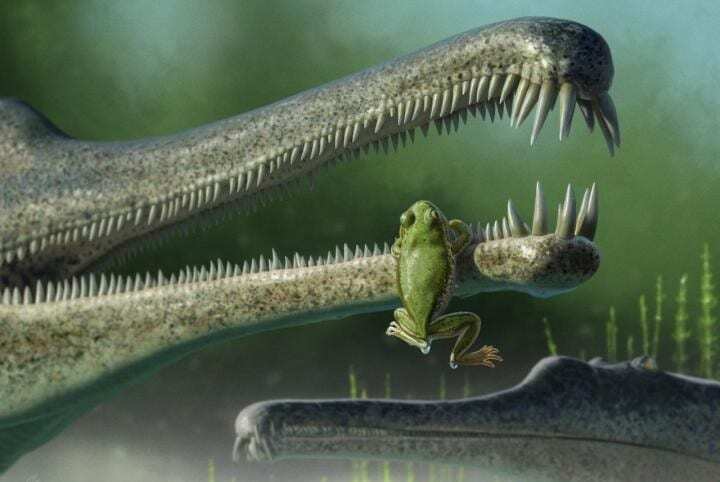A team of palaeontologists led by Virginia Tech’s Michelle Stocker and Sterling Nesbitt of the Department of Geosciences have identified fossil fragments of what are thought to be the oldest known frogs in North America.
The fossils are comprised of several small pieces of hip bone, called an ilium, from Chinle frogs, a distant long-extinct branch of, but not a direct ancestor of, modern frogs. The fragments are packed into rock and are smaller than a pinky nail. They represent the first known and earliest equatorial remains of a salientian — the group containing living frogs, and their most-closely related fossil relatives — from the Late Triassic, roughly 216 million years ago.
The name of the fossil derives from where they were found, the Chinle Formation of Arizona.
Stocker, an assistant professor of geosciences in the Virginia Tech College of Science, says the fossils, discovered in May 2018, underscore the importance of microfossil collection and analysis for understanding extinct species whose total length is under three feet in length.
“This new find highlights just how much there is still to learn about the Late Triassic ecosystem, and how much we find when we just look a little closer,” Stocker said. “We’re familiar with the charismatic archosaurs from the Chinle Formation, but we know that based on other ecosystems, they should make up a small percentage of the animals that lived together. With this new focus we’re able to fill in a lot of those missing smaller components with new discoveries.”
Coming from multiple individuals, the hip bones are are long and hollow, with a hip socket offset rather than centered. The bones of the frogs show how tiny they were: Just a bit over half-an-inch long. “The Chinle frog could fit on the end of your finger,” Stocker added.
Stocker and her team include researchers from Virginia Tech, Arizona’s Petrified Forest National Park, and the University of Florida’s Museum of Natural History, with the findings published today in the online journal Biology Letters. Even though the fossils are part of the Chinle frog family, they are not yet naming the specific fossils.
“We refrain from naming this Chinle frog because we are continuing to process microvertebrate matrix that will likely yield additional skull and postcranial material that has the potential to be even more informative,” Stocker added.
The Chinle frog shares more features with living frogs and Prosalirus, an Early Jurassic frog found in sediments from the present-day Navajo Nation, than to Triadobatrachus, an Early Triassic frog found in modern day Madagascar in Africa. “These are the oldest frogs from near the equator,” Stocker added. “The oldest frogs overall are roughly 250 million years old from Madagascar and Poland, but those specimens are from higher latitudes and not equatorial.”
Added Nesbitt, also an assistant professor of geosciences, “Now we know that tiny frogs were present approximately 215 million years ago from North America, we may be able to find other members of the modern vertebrate communities in the Triassic Period.”
(During the Triassic, the separate continents we recognize today formed the single landmass named Pangaea. Present-day Arizona was located roughly 10 degrees north of the equator.)
The team added this discovery also marks the first time that frog fossils have been found directly with phytosaurs, and other early dinosaurs.
The Virginia Tech team included both undergraduate and graduate students from across the university, using fossils found in the field and dousing additional rock samples repeatedly in water buckets. Further study of the fossils was completed by CT scans. The undergraduates who accompanied Stocker and Nesbitt on the spring 2018 expedition to Arizona included Elizabeth Evans, a major in the School of Performing Arts; Rebecca Hawkins, majoring in the Department of Fish and Wildlife Conservation; and Hector Lopez, majoring in biological sciences.
“Through my internship with Drs. Stocker and Nesbitt in Arizona, I learned firsthand the hard work that paleontologists put into finding fossils,” said Hawkins, a sophomore in the College of Natural Resources and Environment. “Every day you have to brave long treks, heavy loads, scorching heat, and more. But, with just the right combination of patience and luck, you can find something truly amazing that makes the toil worth it, like a tiny frog hip that tells a big story.”
“Our development of methods that recover delicate bones from small-bodied vertebrates enabled this exciting discovery,” said Ben Kligman, a Ph.D. student in Geosciences from Philadelphia, Pennsylvania. “Our aim is to use similar techniques in the Chinle Formation to uncover the early history of other small-bodied animals including lizards, salamanders, turtles, and mammals.”
Header Image – A concept rendering of a Chinle frog, inside the jaw of a phitosaur. Image by Andrey Atuchin. Credit : Virginia Tech








